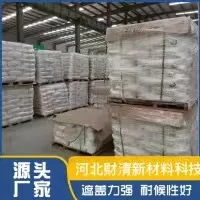
Mei . 20, 2025 11:36 Kembali kepada senarai
Selecting the Right Titanium Dioxide Grade for Paint Formulations
The process of incorporating titanium dioxide powder into paint formulations represents a complex interplay of materials science and colloidal chemistry. Creating high - performance titanium dioxide paint requires careful consideration of multiple formulation parameters to fully realize the pigment's potential. The journey begins with the selection of the appropriate titanium dioxide grade, as not all TiO₂ powders are equally suited for every paint application.

Crystal Structure Considerations in Titanium Dioxide Pigment Selection
Paint chemists must consider the crystal structure of the titanium dioxide pigment they select. TiO₂ exists in several crystalline forms, with rutile and anatase being the most common for paint applications. Rutile titanium dioxide, with its higher refractive index and greater stability, has become the preferred choice for most coatings. The anatase form, while initially brighter, tends to exhibit higher photocatalytic activity and is more prone to chalking in exterior applications. Modern titanium dioxide coating formulations almost exclusively use surface - treated rutile TiO₂ to optimize both initial performance and long - term durability.
The Significance of Surface Treatment in Titanium Dioxide Powder for Paints
The surface treatment of titanium dioxide powder is another critical consideration. Most commercial TiO₂ pigments receive inorganic coatings of silica, alumina, or zirconia to modify their surface properties. These treatments serve multiple purposes in titanium dioxide paint formulations. They improve the pigment's dispersibility in various media, reduce its photocatalytic activity (which could otherwise degrade the organic binder), and enhance the pigment's compatibility with different resin systems. The type and extent of these surface treatments vary depending on the intended application of the final coating, with exterior paints typically requiring more extensive treatment than interior formulations.
Dispersion Technology: Unleashing Titanium Dioxide's Potential in Paints
Dispersion technology represents perhaps the most crucial step in unlocking titanium dioxide's full potential in paint applications. Proper dispersion of titanium dioxide pigment involves breaking down agglomerates and achieving a uniform distribution of primary particles throughout the paint medium. This process typically requires high - shear mixing equipment and often involves specialized dispersing agents. The quality of dispersion directly impacts several key paint properties, including gloss development, color strength, and storage stability.
The Role of Critical Pigment Volume Concentration in Titanium Dioxide Coatings
In titanium dioxide coating formulations, the concept of "critical pigment volume concentration" (CPVC) plays a pivotal role. This represents the point at which there's just enough binder to coat all pigment particles and fill all voids between them. Formulating near but below the CPVC allows paint chemists to maximize hiding power while maintaining good film integrity. Titanium dioksida's high refractive index means that paints can achieve excellent opacity at relatively low pigment volume concentrations, leaving more room in the formulation for durable resins and other performance - enhancing additives.
Titanium Dioxide's Influence on Paint Rheology and Formulation Adjustments
The interaction between titanium dioxide powder and the binder system also affects the rheological properties of the paint. TiO₂ particles can influence viscosity, settling behavior, and application characteristics. Modern titanium dioxide paint formulations often include rheology modifiers to counteract these effects, ensuring good brushability, leveling, and sag resistance while maintaining the pigment's optimal dispersion state.
-
Why Rutile Titanium Dioxide Is Preferred in Plastic Manufacturing
BeritaJul.21,2025
-
Why High-Quality Printing Paper Cannot Do Without Titanium Dioxide
BeritaJul.21,2025
-
Why Exterior Wall Coatings Prefer Rutile Titanium Dioxide
BeritaJul.21,2025
-
Optical Properties and Light Interaction of Titanium Dioxide
BeritaJul.21,2025
-
How to Determine the Effectiveness of Using Titanium Dioxide in Coatings
BeritaJul.21,2025
-
Comparing the Advantages of Titanium Dioxide with Other Paper Whitening Agents
BeritaJul.21,2025
